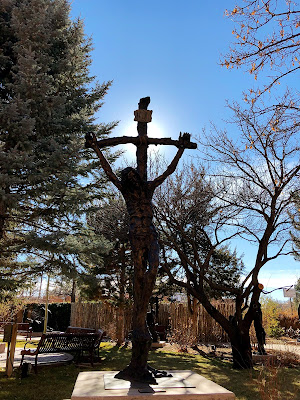Santa Fe, the religion, the history and the culture
We spent two days in Santa Fe, not voluntarily: I somehow hurt my neck and shoulder and I can't move without pain. Overall, Santa Fe is a very small and peaceful town. We are lucky enough to have a good weather, so everything looks delightful.
On my second day in Santa Fe, we went to history museum of Santa Fe. In summary, the history of New Mexico is invasion of Spanish, independence of Mexico, rebellion of Indians, and US occupation of New Mexico (and Texas, California, Nevada). When Mexico becomes independent of Spain, one of the rules is that Catholic is the only true religion of Mexican. I've never quite figured out the difference between Catholicism and Christianity. It looks like Christianity is the general name of the religion. Catholicism, or the Catholic Church, is the oldest branch of it. The difference I was looking for is between Catholic Church and Protestants. The latter is originated by Henry VIII, the fantastic England king that had six wives (another interesting history I learned from my UK trip and watching the Tudors). Protestantism was first started by Henry VIII, in my opinion, to find a reason to divorce his first wife and marry Anne Boleyn, whom got her head chopped because she could not deliver a boy to the king. Idol worship is prohibited in Protestantism, so followers only pray to the Cross. While in Catholic church, you can see status of Jesus Christ, Virgin Mary and other Saints. Protestants believe every one can communicate with God, and should be able to read Bibles, so Bibles were translated from Latin to different languages (e.g. the famous King James Version).
The Loretto chapel is famous for its mysterious staircase. The story was that St. Joseph, the patron saint of carpenters built it (see here). Honestly, it doesn't look that magnificent considering how many such such staircases I've seen in current days. However, it was kind of amazing in the year it was built (1878).
Bandelier national monument was the homes of ancient pueblo people. "Pueblo" is another word I learned from this trip. It means the Indian people settlement in southwest America. The fun part is climbing into those caves and see the homes of different hierarchy of those people (in my imagination): rich people usually have larger caves with multiple rooms, middle classes have smaller ones, some also have multiple rooms, while the smallest one room caves belong to the lower class. The highest and largest cave is always used for ritual purposes.
On my second day in Santa Fe, we went to history museum of Santa Fe. In summary, the history of New Mexico is invasion of Spanish, independence of Mexico, rebellion of Indians, and US occupation of New Mexico (and Texas, California, Nevada). When Mexico becomes independent of Spain, one of the rules is that Catholic is the only true religion of Mexican. I've never quite figured out the difference between Catholicism and Christianity. It looks like Christianity is the general name of the religion. Catholicism, or the Catholic Church, is the oldest branch of it. The difference I was looking for is between Catholic Church and Protestants. The latter is originated by Henry VIII, the fantastic England king that had six wives (another interesting history I learned from my UK trip and watching the Tudors). Protestantism was first started by Henry VIII, in my opinion, to find a reason to divorce his first wife and marry Anne Boleyn, whom got her head chopped because she could not deliver a boy to the king. Idol worship is prohibited in Protestantism, so followers only pray to the Cross. While in Catholic church, you can see status of Jesus Christ, Virgin Mary and other Saints. Protestants believe every one can communicate with God, and should be able to read Bibles, so Bibles were translated from Latin to different languages (e.g. the famous King James Version).
 |
| Cathedral Basilica of St. Francis of Assisi |
 |
| Cathedral Basilica of St. Francis of Assisi |
 |
| Cathedral Basilica of St. Francis of Assisi |
 |
| Cathedral Basilica of St. Francis of Assisi |
The Loretto chapel is famous for its mysterious staircase. The story was that St. Joseph, the patron saint of carpenters built it (see here). Honestly, it doesn't look that magnificent considering how many such such staircases I've seen in current days. However, it was kind of amazing in the year it was built (1878).
 |
| Staircase at Loretto Chapel |
Bandelier national monument was the homes of ancient pueblo people. "Pueblo" is another word I learned from this trip. It means the Indian people settlement in southwest America. The fun part is climbing into those caves and see the homes of different hierarchy of those people (in my imagination): rich people usually have larger caves with multiple rooms, middle classes have smaller ones, some also have multiple rooms, while the smallest one room caves belong to the lower class. The highest and largest cave is always used for ritual purposes.
 |
| Totem |
 |
| The neighborhood :D |
 |
| Outside a cave |
 |
| Inside a cave |
 |
| Me climbing to the aclove house |
 |
| Me |
 |
| A new squirrel species I leaned: Abert squirrel |
 |
| Four of the nine dears I saw |


Comments
Post a Comment